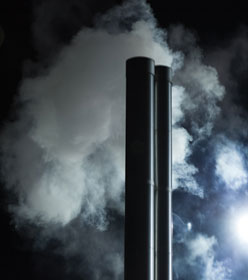

In utility operation, operators are not just responsible for delivering steam, electricity, and other utilities to the production processes, they are key to the entire operation’s profitability. Powerhouse performance not only impacts production rates and quality targets, but also significantly affects the cost of goods sold.
But, the only constants in a modern production environment are demand swings and unforeseen events. Fuels are inconsistent, machinery breaks and human errors disrupt the operation. In short, keeping steam in the pipes is easier said than done. Nevertheless, something approaching stability must be maintained in the powerhouse, while environmental constraints become tighter and rising costs threaten the budget.
The success of the plant hangs in the balance, utilities need to produce more intelligently and cost-effectively – and they need to do it fast.
What is preventing steam reliability while at the same time reducing energy costs and emissions?
Demand swings inhibit stability and reliability.
The unpredictable demands placed on the powerhouse are matched only by the potential for mechanical process disruptions in the operation, and human error just makes things worse. There are inefficiencies in the operation, but with the present equipment, control technology and operating methods, performance can only be managed as best as possible.
Energy costs are high and rising.
Rising energy costs impact not only the power and utility operation, but the bottom line of the entire business. Ideally, increasing the use of low-cost waste and alternate fuels should lower costs, but variations in the BTU content and supply of these fuels makes steady operation difficult and savings hard to come by. What’s more, operators feel like they have better control over utility processes when they run in manual, varying the cost performance between operating shifts.
Instability leads to emissions excursions.
Current environmental permits are tight and are becoming more restrictive over time, making it more important than ever to operate with precise control over emissions. Swings in demand and other operating issues lead to seemingly unavoidable emissions. Running in manual control also contributes to excursions by preventing real-time compensation for changing conditions.
Achieve power and utility performance leadership
The objective, then, should be achieving and maintaining powerhouse performance leadership that gives the ability to deliver utilities reliably while reducing costs and emissions. This may seem a lofty goal, but it is absolutely attainable.
That’s where Emerson comes in. With its unique, holistic approach and industry-leading expertise and technologies, operators can move the performance of the powerhouse to an entirely new level.
Ensure reliable and responsive steam, electric and other utility production.
With improvements in automation, combustion control and process equipment diagnostics, the best operating scenarios can be put into automatic to replicate the most experienced operator’s performance every minute of every day. The benefits of this include:
* Providing the operating team with tools that make it easier to stay on control.
* Optimising overall powerhouse performance in real time.
* Identifying equipment problems before trips or failures.
* Eliminating production disruptions caused by the powerhouse.
Stabilised power and utility operations come about through giving the operating team access to real-time performance intelligence, thus turning them into true process managers.
Decrease energy consumption and minimise fuel costs.
The plant needs to run leaner and smarter, especially when responding to utility demand variations. With Emerson’s end-to-end solutions, operators can reach optimal combustion and maximise the use of lowest-cost fuels. This will achieve the following without sacrificing reliability or responsiveness:
* Stabilise boiler performance.
* Adjust automatically and in real time to fuel supply and quality variations.
* Incorporate emissions and process mechanical constraints into automatic controls.
* Reduce operating cushions that increase cost.
Manage operations safely and automatically within emission constraints.
In order to meet emissions constraints, operators need to improve the combustion performance and begin to operate at a level manual control cannot deliver. With support from Emerson, automatic technologies can be implemented to stabilise combustion such that emissions are managed at all times, even when loads are changing and fuels are varying.
A proven way to achieve full automatic control and optimised unit performance
Emerson’s holistic approach is the key to moving the powerhouse to fully automatic operation with significant fuel cost savings and improved emission performance. It is a step-by-step methodology that begins with a performance audit, delivers a customised improvement solution, and achieves sustained automatic control 95% of the time. It’s a tried and true methodology that can turn any powerhouse into a strategic business advantage.
Process audit: Emerson performs mechanical, process, field device and control system surveys, and analyses recent operating data to fully understand process performance.
Process testing: Operating tests are conducted to determine process constraints and to evaluate alternative operating methods.
Process equipment modifications: Working within business ROI parameters, Emerson recommends upgrades to process and mechanical equipment such as the fuel handling and air-systems, in order to resolve identified limitations.
Field device improvement: From the survey and audit efforts, required measurement and actuation changes are recommended in order to support fully automatic and optimised control.
Control strategy upgrade: Tailored to specific site needs, Emerson develops control strategies for full automatic optimised control.
Commissioning and start-up: With new equipment and strategies in place, Emerson completes field-check, commissioning and start-up tasks for the new equipment and controls.
SOP modification: Operators and maintenance personnel are trained to run processes with the new tools and technology.
Emerson’s top to bottom method to optimise power and utility operations has proven time and again to produce real, measurable and lasting results. Because the solutions are scalable, users can choose to address the most pressing needs before expanding into other areas.
For more information contact Luculle Stols, Automation & Control Solutions, +27 (0)11 249 6702, luculles@aveng-acs.com, www.aveng-acs.com
| Tel: | +27 11 249 6700 |
| Fax: | +27 11 474 8368 |
| Email: | rfq@acs-autocon.com |
| www: | www.acs-autocon.com |
| Articles: | More information and articles about Automation Control Solutions |
© Technews Publishing (Pty) Ltd | All Rights Reserved